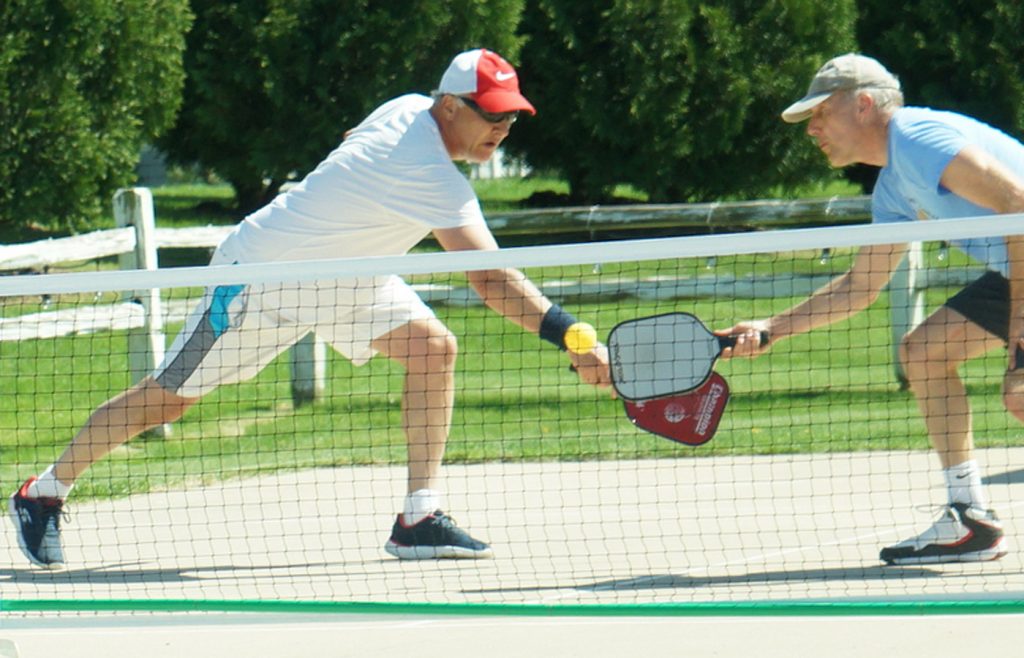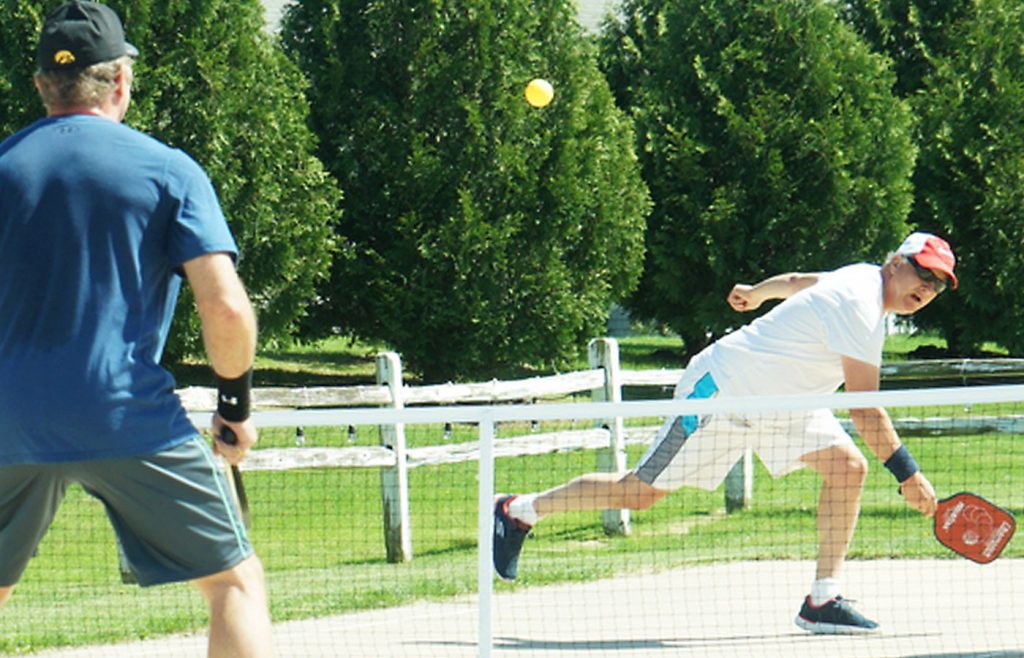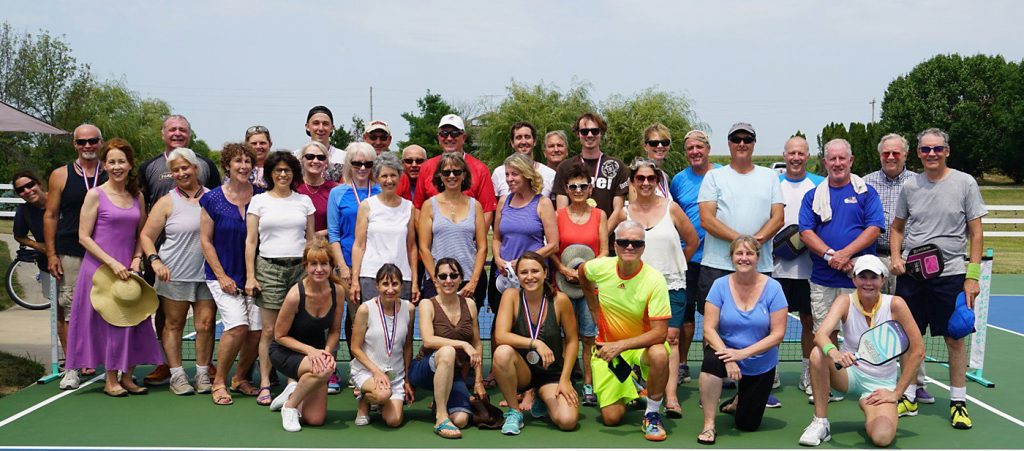
The Fairfield Pickleball Club hosts the Second Annual Regional Tournament on Saturday, January 19, 2019, at the MUM Rec Center in Fairfield. To register, contact Ron Bessette at ron@pcklball.com or go to Fairfield Pickleball Club on Facebook.
Pickleball. Indeed. Is that really the name of America’s fastest-growing sport?
Pickleball—a game that uses no pickles whatsoever. A pickle, after all, would not bounce high enough to hit, and would certainly explode on contact (imagine all those bursting gherkins).
But seriously… The popularity of this sport is surging. According to a Sports & Fitness Industry Association report in 2017, about 2.8 million people play pickleball in the U.S. There are over 12,000 pickleball courts in North America, with the number increasing at a rate of 76 per month. Courts are springing up at recreation centers, retirement communities, schools and YMCAs.
Many players, I learned recently on Fairfield’s courts, know the unusual story of how the game got its name. It arose out of some silliness (or perhaps a creative slump) on the part of its family of origin: the trio of Congressman Joel Pritchard, Barney McCallum, and Bill Bell, who invented pickleball in the summer of 1965 on Bainbridge Island, Washington, as a way to entertain their families.
The sport was named when Pritchard’s wife Joan gazed long and hard at their ball-stealing cocker spaniel, Pickles, and made history when she announced, “So anyways, what the hell, let’s just call it pickleball.”
Of course.
So what is pickleball, exactly?
Pickleball (n): a paddle sport that combines elements of badminton, tennis, and table tennis, played on a badminton-like court that uses a 36-inch-tall net.
In this era of cultural appropriation, why not blend three established sports into a new one that’s, well, super fun and maybe just a tad easier to play?
A Popularity Surge
Though it’s been around for 50 years, pickleball has suddenly become all the rage. Why? Perhaps the technology field can offer a clue. When a product’s sales surge past its small pool of early users to become a mass market phenom, it is said to have “crossed the chasm.” Pickleball, after five decades, has done exactly that over the last three years.
Last week, I arrived at Fairfield’s pickleball courts to see if I could learn why. A dozen or so players were practicing rallies, tapping the ball back and forth over the net.
“What is pickleball?” I asked.

“Most people start out thinking it’s mini-tennis,” said Ron Stakland, 64, a food industry executive who built a pickleball court in his driveway. “We all started out that way. They think they can stand at the baseline and whale away at the ball. But that’s not how the great players do it. Ninety percent of it is dink shots and drop shots. Dink, dink, dink, then wait for a flub from the other side and put it away and end the point.”
Pickleball rules are similar to the rules of doubles badminton. The ball must be served with an underhand stroke. Quickness and finesse often win out over heavy groundstrokes and intense topspin.
A Boomer Obsession
It took just a glance at the players around me to see that pickleball is especially attractive to people of a certain age. “You can play it,” chuckled one player, “without having to run too much.”

“Pickleball is for older folks who can’t play tennis anymore,” said Chris Stanley, 48. “People are living longer and they want a sport they can keep playing into their 60s, 70s, 80s, and 90s.”
About three-quarters of players are 55 and older, according to the Sports & Fitness Industry Association. But in truth, the game is enjoyed by all ages, and oftentimes hypercompetitively. Several Fairfielders have brought home medals from tournaments held around the state.
One curious aspect of the game is the ball: a plastic 26-40-hole whiffle ball that tends to bounce low and come at you much slower than a tennis ball. Which means you have time to whomp it—and watch as it slows down as it approaches your opponents, giving them time to whomp it back. Or dink it.
Players will often stand a few feet from the net—while avoiding stepping into “the kitchen,” the area on either side of the net—smacking the ball back and forth in lightning-fast rat-a-tat exchanges.
“The whiffle ball is less lively than a tennis ball, meaning it’s easier to hit,” said Stakland. “Points last longer than in tennis.” Another benefit of the ball speed is that it doesn’t hurt nearly as much when it thwacks you.
Players’ skills are rated on 1–7 scale. Many Fairfielders are in the 2.5 to 3.5 range. Being a lifelong tennis player, I learned pickleball relatively quickly, though I was told I probably wouldn’t score a single point against a 5-rated player. Which made me desperately want to find one of Fairfield’s 5-rated players. . .
Great Game for the Times
Personally, I wish the Pritchetts had named their dog Rocket Paddle. Or consulted with branding experts. Or been more danged patient. Coining a term is a serious business. A few of the Fairfield players had their own ideas.
“It should be called Danger Ball,” said Tim Hoehner, a local player.
“Giggleball,” said Paul Stokstad, another area player. “There’s nothing funnier than a grown adult swinging mightily at a tiny target and completely missing it.”
“The name is, well… unfortunate,” said Martha Knight.
“I don’t care,” said another player. “It’s so much fun.”
Many of the players I met have never played a sport, until now.
“People who are competitive get what they need in pickleball,” said Thom Krystofiak, 64, a technology worker. “It’s fun for the less intense players, too.”
Maybe things seem light-spirited on these courts because they’re located in Iowa, the state that ranks #1 for lowest mental distress, according to a recent U.S. News & World Report’s best states for aging list.
Pickleball may have crossed the chasm because it promises a positive experience in these heavy times, when the country and the world are in need of cooperation and harmony. And just plain, forget-about-everything fun.
Perhaps that’s the spirit Joan Pritchett tapped into when she put the pickle in pickleball. Just keeping things light. Maybe she had nailed the branding, after all.
“I love the social aspect,” said Hoehner. “I’ve expanded my network of friends. If you’re playing for something bigger and better than yourself, the magic can happen.”
If you want to try your hand at pickleball, you may have to find a way to explain to friends and family that what you’re doing doesn’t involve anything moist, briny, or fermented. But then, at the rate this sport is spreading, you probably won’t have to.
For more information about pickleball in Fairfield, email ron@pcklball.com.
Contact writer:
info@warrengoldie.com
www.WarrenGoldie.com
